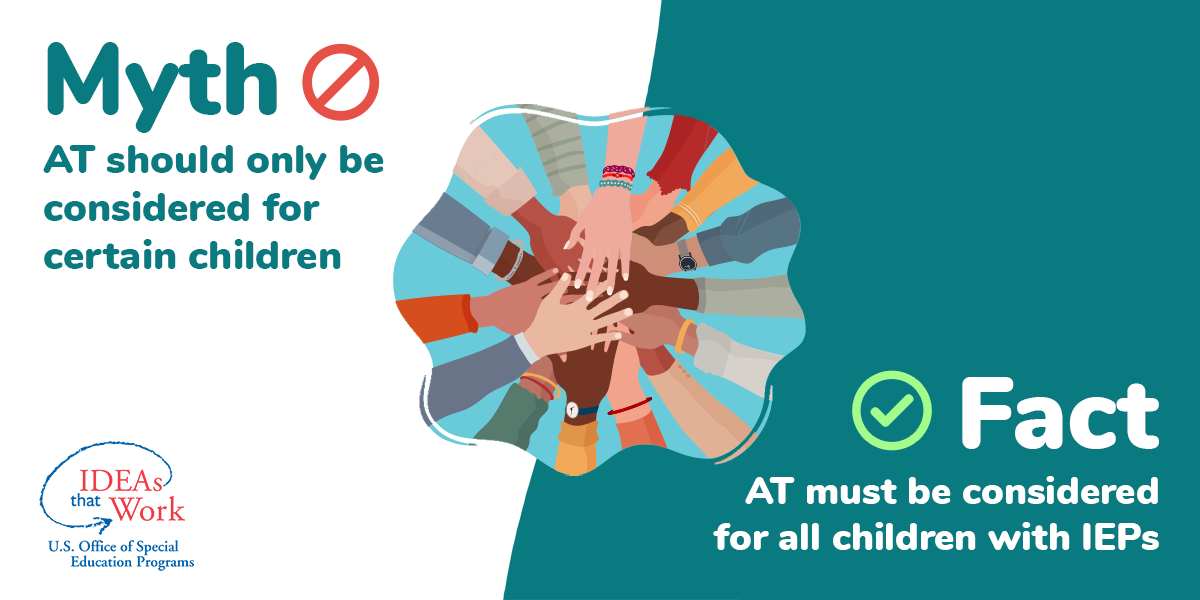Identifying the Student’s Needs
Identifying the Student’s Needs and Required Tasks
Before determining the tool, device, and/or accessible format that may belong in the student’s IEP, the educational team needs to identify the student’s needs, anticipated tasks, and environments. Teams must identify what specific task or educational goal the student needs to do that is currently difficult or impossible. The AT Domains document may help the team to learn more about the descriptions of the various areas of AT and AEM.
Considering the various areas of AT and AEM, begin with the question: What do we expect the student to be able to do within the educational program that they are not able to do because of their disability? With the goal of independence, efficiency, or effectiveness for their tasks, consider these scenarios:
- Braden, a 7-year-old student is unable to use a pencil to write letters and words clearly. Currently, he dictates answers to his teacher for many assignments, while his peers can independently write using pencils or type on the computer. How could the use of AT allow Braden to independently write answers for school assignments?
- Lupita, an 8-year-old student is having difficulty viewing the text in her second-grade books because the text is too small for her to see. Her peers read the text aloud to her but are not always available. How could the use of AT and/or AEM allow Lupita to independently gain information from the text material?
- Connor, a 13-year-old student can access writing tools and a computer to complete assignments. However, because of severe spelling and grammar errors, most of his production of written work is not equal to the quality expected at his grade-level, despite explicit instruction in these areas. Connor is still expected to spell and use grammar at the level of same-age peers. How could the use of AT allow Connor to improve spelling and grammar in all assignments?
- Malik, a student with developmental disabilities, is fully included in a fourth-grade classroom. Malik’s parents want them to participate in all academic activities as their same-age peers. Learning the grade level content and completing all the assignments on time is becoming more challenging for Malik. Therefore, a full-time aide is needed to complete assignments. How could the use of AT allow Malik to access the curriculum and complete assignments more independently?
- Lisa, a student with significant communication and behavioral challenges, receives most of her specialized instruction in a self-contained special education classroom. She initiates a few signs and uses gestures to obtain her wants and desires. She frequently displays verbal and physical behaviors that can be distracting during classroom activities when her peers don’t understand what she is trying to communicate. Because of this behavior, her opportunities to remain engaged in the general education activities are limited. How could the use of AT provide Lisa with a way to communicate her needs more effectively?

AEM Tie-In:
Accessible formats should be considered for all children with IEPs.
Each of these students experience barriers in participating in classroom activities through typical modes due to their disabilities. Determination of special education services and goals/objectives must be based on a clear understanding of the student’s needs and the classroom expectations. In all the above student scenarios, considering the use of AT and/or AEM supports the student’s participation and access within the classroom settings.
The use of AT and/or AEM may help the student:
- Receive instruction within the least restrictive environment (LRE).
- Participate and make progress in the grade level standards (e.g., reading, writing, math, science, etc.).
- Participate in extracurricular and non-academic activities (e.g., music, art, sports, functional activities such as orientation and mobility, independent living skills, etc.).
- Use accessible format materials (e.g., audio, braille, large print, tactile graphics, and digital text conforming with accessibility standards).
- Access auditory and visual information.
- Enhance communication and social interactions.
- Participate in readiness activities for postsecondary training and education, competitive integrated employment, and independent living.
- Participate in state and local assessments.
NOTE: This should not be considered a comprehensive list.
For more information about the consideration process, visit the ATIM module AT Consideration in the IEP Process.
